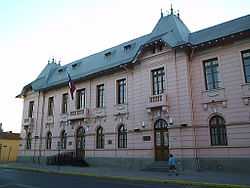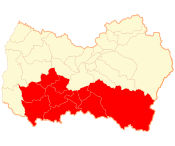Colchagua
| Colchagua Provincia de Colchagua | ||
|---|---|---|
| Province | ||
 | ||
| ||
 | ||
 Colchagua | ||
| Coordinates: 34°41′S 71°09′W / 34.683°S 71.150°WCoordinates: 34°41′S 71°09′W / 34.683°S 71.150°W | ||
| Country | Chile | |
| Region | O'Higgins | |
| Capital | San Fernando | |
| Communes | ||
| Government | ||
| • Type | Provincial | |
| Area[1] | ||
| • Total | 5,678.0 km2 (2,192.3 sq mi) | |
| Area rank | 2 | |
| Population (2002 Census)[1] | ||
| • Total | 196,566 | |
| • Rank | 2 | |
| • Density | 35/km2 (90/sq mi) | |
| • Urban | 115,043 | |
| • Rural | 81,523 | |
| Sex[1] | ||
| • Men | 98,982 | |
| • Women | 97,584 | |
| Time zone | CLT [2] (UTC-4) | |
| • Summer (DST) | CLST [3] (UTC-3) | |
| Area code(s) | 56 + 72 | |
| Website | Government of Colchagua | |
Colchagua (Spanish: Provincia de Colchagua) is one of three provinces of the central Chilean region of O'Higgins (VI). Its capital is San Fernando. It is bordered on the north by Cachapoal Province, on the east by the Argentine Republic, on the south by Curicó Province, and on the west by Cardenal Caro Province.
Geography and demography
The area of Colchagua is officially estimated at 5,678 km2 (2,192 sq mi) with a population (2002 census) at 196,566. Extending across the central valley of Chile, the province has a considerable area devoted to traditional agriculture and wine-growing. Its principal rivers are the Rapel River and its tributary, the Tinguiririca.
The principal towns are San Fernando, the provincial capital, Santa Cruz, Chimbarongo, Nancagua and Palmilla. San Fernando is one of the several towns founded in 1742 by the governor-general José Antonio Manso de Velasco, and it had a population of 64,000 in 2002.
Administration
As a province, Colchagua is a second-level administrative division of Chile, governed by a provincial governor who is appointed by the president. The province comprises eleven communes, each governed by a municipality consisting of an alcalde and municipal council.
Transport
The state central railway (EFE) from Santiago to the south crosses the province and has a regular stop in San Fernando. It used to have a branch running from San Fernando via Palmilla to Pichilemu on the coast. This is now closed, although one section of it has recently opened a limited service aimed at the tourist trade.
The more local Metrotrén service runs between Santiago and San Fernando stopping at most of the towns in between. There are frequent trains between these two points.
The Pan-American Highway runs through the San Fernando commune, passing close to the east side of the town.
Colchagua Valley wine region

Colchagua Valley, along with the Maipo Valley to the north, is one of Chile’s best known wine regions. It was named “World’s Best Wine Region 2005” by Wine Enthusiast Magazine[4]
and is known for its full-bodied Malbecs, Cabernet Sauvignons, Carmeneres and Syrahs.
Located 180 km (110 mi) south of Santiago, the Colchagua Valley occupies the southern part of the larger Rapel Valley, with the lesser-known Cachapoal Valley lying to the north. Colchagua vineyards run from the Andes Mountains in the east to the Coastal Range in the west. Most of Colchagua's most important vineyards lie in the foothills of the Coastal Range, as well as the sub-regions of Apalta, Peralillo and Lolol.
The Colchagua Valley has a slightly cooler climate than the Maipo Valley, but maintains a consistently Mediterranean climate, like most of Chile’s wine regions. It is located at 34°S, closer to the Equator than any European vineyard, but the Pacific Ocean brings a regular cooling influence over the valleys. Colchagua’s red varietals - Cabernet Sauvignon, Carmenere, Malbec and Merlot - tend to be planted in the warmer east of the region, with the white Chardonnay and Sauvignon Blanc varietals in the cooler, ocean-influenced west.[5]
The region is characterized by steep slopes of well-drained granitic soil, irrigated by the Tinguiririca River which flows through the valley bringing clear melt water from the Andes.[6]
Grape distribution by varietal
- Climate: Mediterranean, 592 mm (23.2 in) annual rainfall.
- Soils: clay, sand, decomposed granite.
- Primary wines: Cabernet Sauvignon, Carmenere, Syrah and Malbec.
| Cabernet Sauvignon: 11,117 ha (27471 acres) | Merlot: 2,953 ha (7297 acres) | Carménère: 3,120 ha (7710 acres) |
| Syrah: 1,984 ha (4903 acres) | Sauvignon Blanc: 1,263 ha (3121 acres) | Chardonnay: 1,845 ha (4559 acres) |
| Viognier: 335 ha (828 acres) | Malbec / Cot: 559 ha (1381 acres) | Cabernet Franc: 508 ha (1255 acres) |
Total hectares planted: 1,421 ha (3,511 acres)[7]
See also
- Chilean wine
- Tinguiririca River
- Maipo Valley
References
- ↑ 1.0 1.1 1.2 (Spanish) Instituto Nacional de Estadísticas
- ↑ "Chile Time". WorldTimeZones.org. Retrieved 2010-07-28.
- ↑ "Chile Summer Time". WorldTimeZones.org. Retrieved 2010-07-28.
- ↑ Colchagua Valley www.winesofchile.org all right reserved, retrieved September 23, 2013/
- ↑ Chile's first Grand Cru appellation? www.wine-pages.com/ by Wink Lorch
- ↑ Colchagua Valley Wine www.wine-searcher.com Published by Wine-Searcher.com Last updated September 20, 2013 by Wine-Searcher Staff, retrieved September 23, 2013
- ↑ See Colchagua Valley Chart www.winesofchile.org all right reserved, retrieved September 23, 2013/
| |||||||||||||||||

